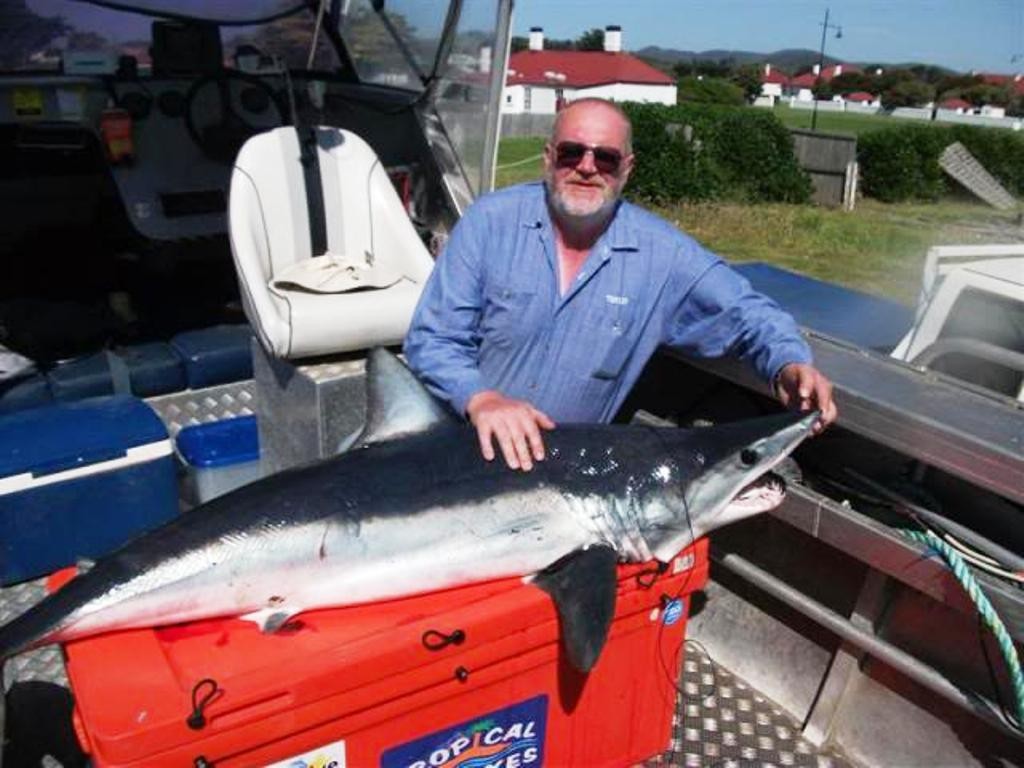Sharks in Tasmania
by Carl Hyland on 28 Nov 2011

Greg with a Shortfin Mako off Low Head. Carl Hyland
In Tasmanian waters, we have many species of shark. These are a source of game fishing captures and also researched by scientists from around the world.
For a period of time, it was believed the Shortfin Mako was in danger of becoming a threatened species and in fact was placed on the threatened species network register for a period of time, but after consultation with scientists and game fishermen, the ban was lifted in Australian waters.
Some species cannot be captured still and these include the Great white, of which numbers are threatened in Tasmanian waters.
Shark fishing is immensely popular in the Island state, so much so, that is all the fishing some do from ports such as Low Head, Ulverstone and Eaglehawk Neck. The Tuna Club of Tasmania has now a shark category in all its competitions where most species of sharks can be tagged and released and points awarded for such captures. Shortfin Mako is used as a food source for some anglers fishing in state waters and usually smaller specimens (50kg-100kg) are taken.
Tiger sharks are virtually unheard of in this state as water temperatures are too low but occasional specimens do turn up from time to time. The most common catch by land based game anglers are the Seven Gilled shark and the gummy shark. Unwanted captures are usually the Port Jackson sharks or Wooblegongs.
I must tell you of a great book I have managed to obtain and it is readily available and it is White Pointer South by Chris Black of Hobart. This book is the most comprehensive recording of not only shark attacks, but factual case histories and scientific information that is available.
This is a diligently researched volume ... a valuable reference text for students, professional scientists, naturalists, professional and recreational fishers, divers and all those with a fascination of sharks and the sea. Barry Bruce Senior Research Scientist,CSIRO Marine & Atmospheric Research Hobart, Tasmania.
Completely updated and featuring sixty pages of extra content, this new edition is an unprecedented and visually rich reference work that documents over two-hundred years of human/shark interactions in south-east Australian waters.
Gain a better understanding of the occurrence of white sharks (and other species) in the sea surrounding Australia’s island state and the threats which continue to beset these magnificent predators as they negotiate its rugged coastline.
Read about changing human attitudes towards sharks in Tasmania - from the fear and loathing of sharks in general, to the enactment of legislation designed to protect the most feared shark of all from exploitation. Explore a comprehensive chronology of Tasmanian white shark captures spanning sixty-four years. Discover the key reasons for white shark mortality in south-east Australian waters and what can be done to help mitigate the toll taken on shark numbers as a result of by catch.
Examine Tasmania's eleven recorded shark attacks in an updated and detailed survey that deals with facts rather than the sensationalism which typically attends this subject.
Relive exciting and sometimes harrowing encounters with white sharks through the firsthand narratives of island fishermen, fish-farmers, divers and surfers.
Learn about eight other large predatory shark species (mako, porbeagle, blue shark, bronze whaler, thresher, hammerhead, sevengill and sixgill) that share Tasmanian waters with the white shark. Review the latest white shark research currently being conducted by Hobart-based biologists from the CSIRO’s Marine & Atmospheric Research division. The revised full-colour hardback edition of the acclaimed book White Pointer South is available now from Wellington Bridge Press.
Many charter operators specialise in chasing Mako and other species of shark, a couple of these are;
http://www.tunacluboftasmania.org.au/charters/29794.html
http://www.sealandsea.com/
Suddenly, more than ever before, humans effect and influence on a creature that we fear so much, is vital. In Australia, the great white shark is generally misconceived as a ruthless killer with many people questioning the safety of our beaches. Overseas however, great white sharks are more of a positive tourism draw card than an ignored asset.
In South Africa, cage-diving tourism operators are in the dozens, giving thrill seekers the opportunity of a lifetime to see a great white up close. Calypso Star Charters, though only one of two operators here in Australia, also run a very successful business, which attracts tourists from all around the world. Our water here is very clear and you don't need to have your scuba diving license to experience the cage. Rolf Czabayski has been running his tourism operation since 1990 and he says the reactions on the faces of people who experience the thrill of seeing great white sharks, is simply, 'unbelievable'.
Unfortunately, for the great white shark though, the rare accidental fatal attack on human beings continues to override the actual statistics and facts. Truth is, despite the millions of hours people spend in the ocean, you're five times more likely to get struck by lightning than suffer the jaws of a shark. With careful consideration of the facts, perhaps we can begin to see sharks in a different light.
The great white shark is a traveller. It is an iconic and magnificent species. It is playing a vital role in what is the nature of our open oceans. Fearing them is acceptable, but they have been protected for a reason. Let’s keep it that way.
If you want to link to this article then please use this URL: www.sail-world.com/91228